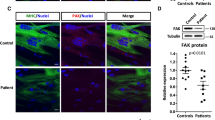Abstract
Phosphoinositides play a central role in the control of major eukaryotic cell signaling mechanisms. Accordingly, the list of phosphoinositide-metabolizing enzymes implicated in human diseases has considerably increased these last years. Here we will focus on myotubularin, the protein mutated in the X-linked myotubular myopathy (XLMTM) and the founding member of a family of 13 related proteins. Recent data demonstrate that myotubularin and several other members of the family are potent lipid phosphatases showing a marked specificity for phosphatidylinositol 3-phosphate [PtdIns(3)P]. This finding has raised considerable interest as PtdIns(3)P is implicated in vesicular trafficking and sorting through its binding to specific protein domains. The structure of myotubularin, the molecular mechanisms of its function and its implication in the etiology of XLMTM will be discussed, as well as the potential function and role of the other members of the family.
Similar content being viewed by others
Author information
Authors and Affiliations
Corresponding author
Additional information
Received 14 February 2003; received after revision 10 April 2003; accepted 14 April 2003
Rights and permissions
About this article
Cite this article
Tronchère, H., Buj-Bello, A., Mandel, JL. et al. Implication of phosphoinositide phosphatases in genetic diseases: the case of myotubularin. CMLS, Cell. Mol. Life Sci. 60, 2084–2099 (2003). https://doi.org/10.1007/s00018-003-3062-3
Issue Date:
DOI: https://doi.org/10.1007/s00018-003-3062-3



